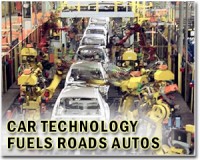 |
Vancouver, British Columbia (UPI) Mar 1, 2011 Canadian researchers say a program by one of the world's largest cities to switch its vehicles to clean fuel has not significantly improved emission levels. Researchers at the University of British Columbia say their study of the impact New Delhi's 2003 conversion of 90,000 buses, taxis and auto-rickshaws to the "clean fuel" of compressed natural gas has had can provide guidance for other cities considering such projects, a university release said Tuesday. Crucially, in New Delhi's 5,000 auto-rickshaws with two-stroke engines -- a widely used form of transportation in both Asia and Africa -- the conversion to natural gas produced only minor reductions in emissions that cause air pollution. The switch actually resulted in an increase in other emissions that negatively impact climate change. The New Delhi program could have achieved greater emission reductions at a cheaper price by simply upgrading two-stroke models to cleaner, more fuel-efficient, four-stroke engines, the researchers said. "Our study demonstrates the importance of engine type when adopting clean fuels," lead author and UBC post-doctoral fellow Conor Reynolds said. "Despite switching to CNG, two-stroke engine auto-rickshaws in Delhi still produce similar levels of particulate matter per kilogram of fuel to a diesel bus -- and their climate impacts are worse than before." As much as one-third of natural gas is not properly burned in two-stroke engines, producing high emissions of methane, a major greenhouse gas that contributes to climate change, the study said. Several Asian cities have even more two-stroke auto-rickshaws than New Delhi, researchers said, including rapidly industrializing cities in India, Pakistan, Bangladesh, Philippines, Thailand, and Indonesia.
earlier related report The US auto giant said in a statement that with its Chinese joint ventures it sold 184,498 vehicles in the country last month, although this was well below the all-time monthly high of 268,071 vehicles set in January. Auto sales are typically slower in February due to China's week-long Lunar New Year holiday. GM set its previous February record for sales in China last year, when it sold 174,306 vehicles, up 51 percent from the previous year. China's booming market has become increasingly important to GM as demand weakens in the United States. China, where GM's international operations are now based, overtook the United States as the world's biggest auto market in 2009. GM and its joint ventures sold a record 452,570 vehicles in China in the first two months of 2011 -- representing a 15 percent increase from the same period last year, the carmaker said. GM's sales in China last year increased 28.8 percent year-on-year to an annual record of 2.35 million vehicles, outstripping sales in the United States. Auto sales in China rose more than 32 percent in 2010 to 18.06 million units, according to the semi-official China Association of Automobile Manufacturers (CAAM). CAAM forecast sales and production would grow at a steadier pace this year, by 10-15 percent, after purchase taxes for small cars rose to 10 percent and Beijing slashed the number of new registrations allowed in the capital. GM has several joint ventures in China including Shanghai General Motors, a partnership with China's largest auto maker SAIC Motor.
Share This Article With Planet Earth
Related Links Car Technology at SpaceMart.com
 China approves BYD-Daimler electric car deal
China approves BYD-Daimler electric car dealBeijing (AFP) March 1, 2011 Chinese auto group BYD and German luxury car maker Daimler have received regulatory approval for their joint venture to develop an electric car in China, the companies said Tuesday. The research and development venture Shenzhen BYD Daimler New Technology Co Ltd was given a business licence nine months after the automakers signed an agreement on the partnership. "Our joint venture is maki ... read more |
|
| The content herein, unless otherwise known to be public domain, are Copyright 1995-2010 - SpaceDaily. AFP and UPI Wire Stories are copyright Agence France-Presse and United Press International. ESA Portal Reports are copyright European Space Agency. All NASA sourced material is public domain. Additional copyrights may apply in whole or part to other bona fide parties. Advertising does not imply endorsement,agreement or approval of any opinions, statements or information provided by SpaceDaily on any Web page published or hosted by SpaceDaily. Privacy Statement |